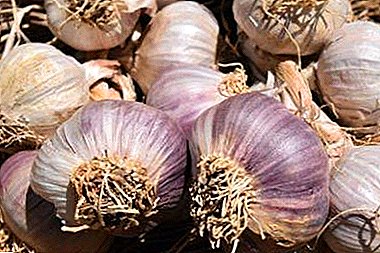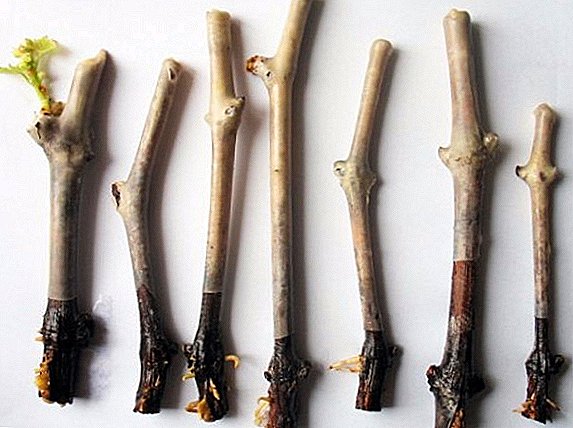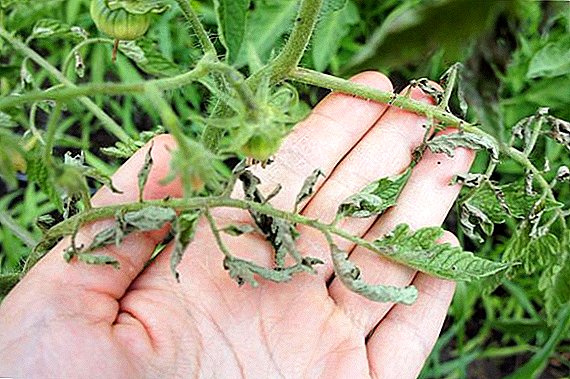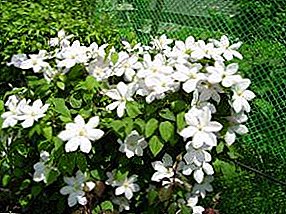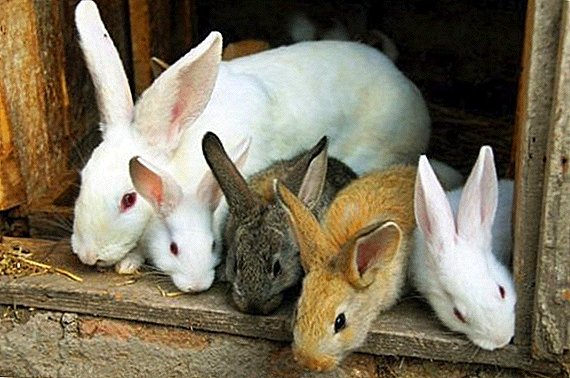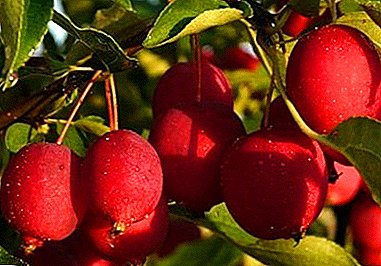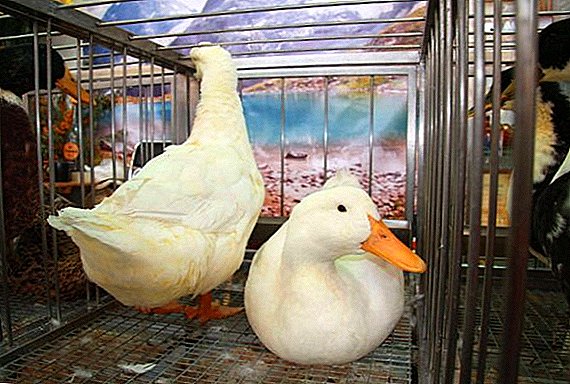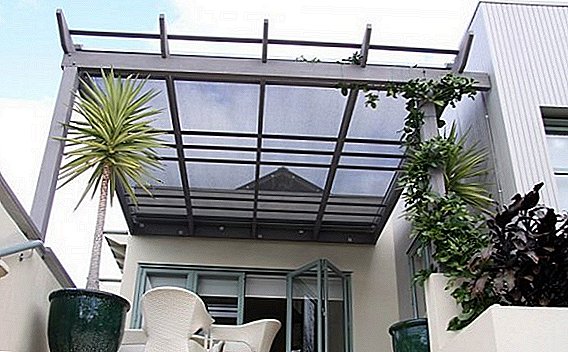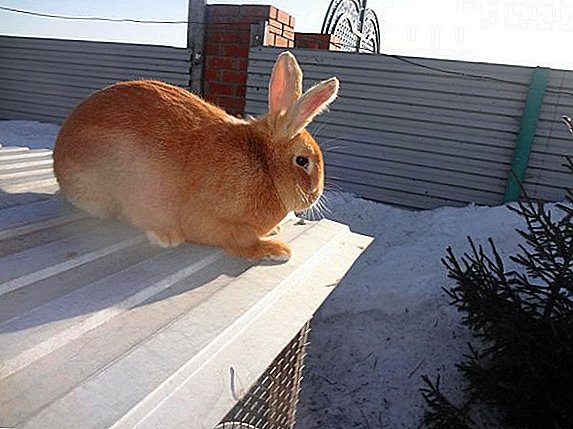 Among farmers and professional breeders, the Burgundy breed of rabbits is known for its excellent meat taste and considerable weight. Having provided the pets with proper care, you can get from one adult female up to 50 young rabbits a year, which is on average equivalent to 200 kg of pure meat. The fur of the Burgundians is not so valuable, the processing of their skins was reputed to be not very profitable. But for domestic use, sewing things that do not require high quality, it is quite suitable. Let's talk in more detail about the benefits of this breed, as well as the features of care for her.
Among farmers and professional breeders, the Burgundy breed of rabbits is known for its excellent meat taste and considerable weight. Having provided the pets with proper care, you can get from one adult female up to 50 young rabbits a year, which is on average equivalent to 200 kg of pure meat. The fur of the Burgundians is not so valuable, the processing of their skins was reputed to be not very profitable. But for domestic use, sewing things that do not require high quality, it is quite suitable. Let's talk in more detail about the benefits of this breed, as well as the features of care for her.
Breed description
Burgundian rabbits have a number of characteristics that distinguish this breed from others.
Did you know? The world record for rabbits in long jump is 3 m.
History reference
As the name implies, the breed was bred in the French province of Burgundy. The "progenitors" were the red New Zealand and California rabbits. It happened at the beginning of the twentieth century, the first standard was introduced in 1914. Over the next 60-70 years, the breed quickly spread throughout the world.  Today, the Burgundian rabbits are actively bred in the Czech Republic and Slovakia, so breeders are guided by the breed standard characteristic of these countries.
Today, the Burgundian rabbits are actively bred in the Czech Republic and Slovakia, so breeders are guided by the breed standard characteristic of these countries.
Did you know? In rabbits, as in humans, there is such a thing as a false pregnancy.
Appearance and physique
The Burgundian rabbit is easily confused with other species, if you do not know several features of the breed. They consist of a fur coat of the animal.
Officially, there are two varieties of these rabbits:
- fauve - it is distinguished by the warm tint of red fur, the second name of which is “gold of Burgundy”;
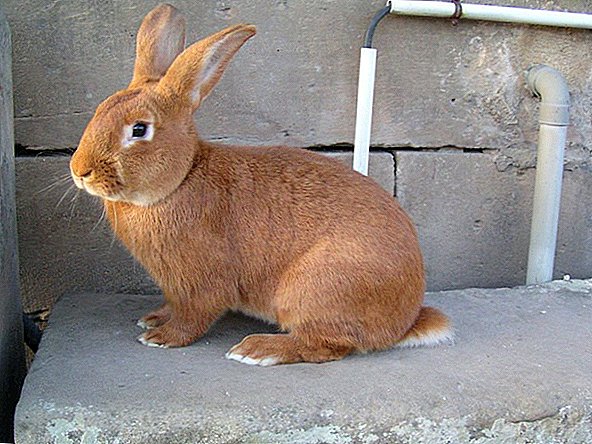
- lapin - this type has a reddish tint of hairs.
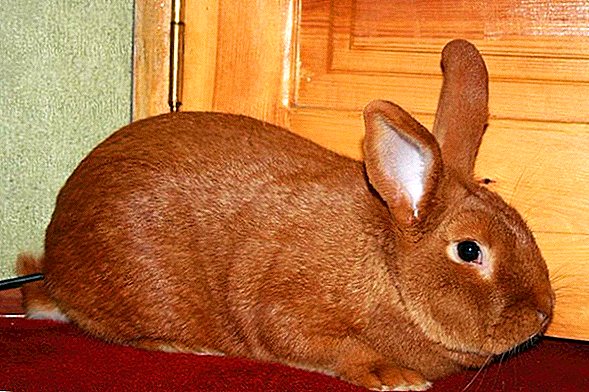
Despite the beautiful, rich color, the fur of the Burgundians is not distinguished by its high value. To the touch it is rough, has up to 16 thousand hairs per 1 square. see At the same time undercoat - no more than 6 mm, and its shades range from light cream to light brown.
In order to properly organize the care and maintenance of eared animals, it is necessary to become familiar with all the subtleties of breeding rabbits at home.
The standard description of an adult, healthy representative of the breed is as follows:
- "downed" strong body with rounded croup;
- flexible, slightly curved back and pronounced chest (females have a clearly shaped dewlap);
- a short neck and a small, slightly elongated head with brown eyes;
- ears upright, in the form of a spoon, up to 11-15 cm long;
- strong, developed front legs.
 In general, the rabbit of the Burgundian breed looks strong, but at the same time harmoniously folded.
In general, the rabbit of the Burgundian breed looks strong, but at the same time harmoniously folded.In the category of marriage include instances in which there is:
- too light color, no saturated color;
- drooping ears longer than standard;
- weight fluctuations in excess of 15-20%.
Did you know? If rabbits are not artificially restricted in breeding, then they will need about 90-100 years to every 1 square. m. of the earth's surface accounted for 1 individual.
Productive qualities
Most often, these beauties are bred for their tasty meat. The average parameters of the representatives of the breed:
- weight - from 4 to 5.5 kg;
- length - 45-50 cm;
- chest girth - about 36-38 cm;
- slaughter - from 60%.

Conditions of detention
Experts attribute the Burgundian rabbit to unpretentious breeds. For its maintenance the minimum conditions are necessary:
- clean litter that needs to be changed regularly;
- constant access to drinking water;
- quality, good nutrition;
- lack of drafts that can cause diseases of the respiratory system;
- shelter from direct sunlight, because of the dense dense fur animals can suffer from the heat.
Agree, one of the factors affecting the success of breeding rabbits, is a spacious cozy room. Learn how to build a rabbitry correctly, how to make cages using the Zolotukhin method, as well as a shed for rabbits with your own hands.
Keep Burgundy rabbits can be both indoors and outdoors. Thanks to the warm coat, they normally tolerate frosts.
The coat on the paws allows them to live in the cells, but it is still desirable for their convenience to cover the grid on the floor with a veil or a rug. 
How to care
The Burgundian rabbits, although they are distinguished by increased immunity, still require high-quality prevention of various viruses and infections. Such prevention consists of 2 stages: cell disinfection and timely vaccination.
Terms and methods of disinfection
Microbes and viruses on the surfaces of rabbit cells are not afraid of moisture, heat or cold. To "evict" them, more radical measures will be needed.
If cleaning and bedding changes take place every 5-7 days (the more rabbits in the same room, the more often), then routine disinfection to prevent the onset of diseases or viruses in the livestock is organized at least 2 times a year.
Did you know? The heaviest rabbit in the world weighed 12.26 kg.
Additionally, it is desirable to do this procedure in the case of:
- the planned transplantation of young animals into common cells;
- preparation for capping;
- disease transmission.
 For disinfection will need:
For disinfection will need:- a broom, brush, scraper or scourer;
- a bucket or box covered with a garbage bag;
- hose with water;
- disinfectant in spray bottle;
- gloves, masks, goggles.

The step-by-step disinfection instruction looks like this:
- Temporarily remove the rabbits from the cage.
- Put on gloves and pull out of the cage everything that is not fixed in order to free up space as much as possible.
- Remove the old litter in the garbage bag, then use scrapers, brushes and a broom to remove all dirt.
- After cleaning the cage, carefully inspect it for damage or damage. If necessary, fix problem areas.
- For the next step, you will need a hose and water. Wash the cell surface well, removing residual dirt. If necessary, alternate between brushes and water.
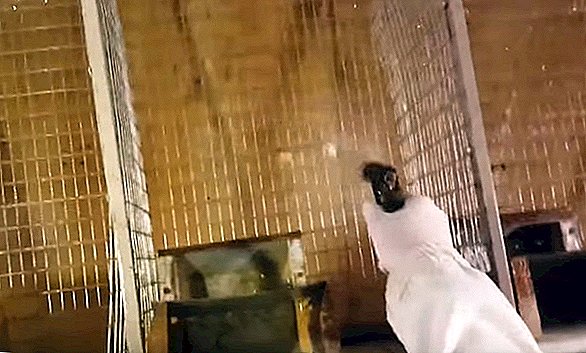
- When the cage is clean, put on a mask, goggles and carefully spray the floor, walls and ceiling of the cage with a disinfectant.

- After processing, once again, run a brush or scraper over all surfaces and rinse them with water.

- Next you need to dry the cage. If possible, do it in the open sun.
- While the cells are drying, you can disinfect the feeders, drinkers, related equipment.
- It does not hurt to wash the room where there are cages with pets.
Video: disinfection on the rabbit farm
The following preparations can be used as disinfectants:
- "Virucide";
- "Ecocide C";
- "Glutex";
- Virosan;
- "Delegol".
Vaccination of Burgundy rabbits
The first vaccine is given to rabbits at the age of 2 months if there is no threat of an epidemic. Otherwise, young animals are vaccinated already on the 30th day of life.
Today the most effective preventive vaccine for rabbits is Rabbiwak V.
The animals do 2 vaccinations:
- from VGBK;
- from myxomatosis.
 Syringe for vaccination of rabbits Periodically, revaccination will be necessary. Its terms depend on the vaccination that you have chosen: each drug has its own duration.
Syringe for vaccination of rabbits Periodically, revaccination will be necessary. Its terms depend on the vaccination that you have chosen: each drug has its own duration.To prevent disease among rabbits, it is important to monitor their condition. Their normal body temperature is 38-39.5 ° C, while the pulse varies between 120-150 beats per minute. Pay attention to the color of their feces: its changes may indicate problems with digestion. If found similar, contact your veterinarian.
What to feed
The Burgundian rabbits are quite picky in their diet, so it is important to make them a varied diet, otherwise they can be capricious. As the livestock is raised for meat, it is necessary to provide the animals with food that promotes the growth of muscle mass.
Rabbit breeders should consider all the details of feeding rabbits.
Usually the menu of rabbits depends on the season:
- in summer it is important to give as much fresh grass as possible, in winter it must be replaced with hay;
- give them roots (boiled in winter or fresh, but crushed, in summer): carrots, potatoes, turnips, etc .;
- stimulate the growth of muscle mass legumes and cereals as natural sources of protein;
- useful will be supplements in the form of wheat, corn kernels, sunflower seeds;

Regardless of the season, make sure that fresh drinking water is available in the drinker: thirst is undesirable for rabbits.
Good pets react to specialized feed, but purchased vitamins are better not to abuse. The peculiarity of the Burgundian breed is that these rabbits are easier to tolerate a lack of vitamins than their surplus. Bone, fish meal, converse or whey are excellent as a useful supplement to nutrition.
Important! If you provide pets with a stable temperature from +10 ° C to +20-22 ° C and humidity at 50-70%, reproduction will take place all year round.
Rearing
The Burgundian breed is very prolific, if you create appropriate conditions for rabbits.
The animals reach sexual maturity at 4 months of age, but in order to create healthy offspring, it is better to reduce them not earlier than after reaching half a year by males and 5 months by females.  The duration of pregnancy in rabbits is 27-30 days. The interesting position of the females is almost negligible, they are extremely active. The only feature that distinguishes them is increased thirst. It persists for the first time after caul, so it is important to monitor the presence of water.
The duration of pregnancy in rabbits is 27-30 days. The interesting position of the females is almost negligible, they are extremely active. The only feature that distinguishes them is increased thirst. It persists for the first time after caul, so it is important to monitor the presence of water.
We recommend that you read about how long it lasts and how to determine the pregnancy of a rabbit.
In one litter is born up to 10-12 rabbits. These are absolutely bald babies whose eyes open only after 2 weeks. After they stop feeding on mother's milk, they need to be evicted, otherwise they can harm the rabbit by their activity.  As soon as the rabbits reach the age of 3 months, they should be separated by gender: no more than 4 females in 1 cage, and the males live alone.
As soon as the rabbits reach the age of 3 months, they should be separated by gender: no more than 4 females in 1 cage, and the males live alone.
Rabbits of the Burgundian breed have a good immunity, so the percentage of survival is very high.
Important! If the rabbit's liquid is not enough, she will start eating the offspring.
Burgundy rabbits are popular among breeders, because they have high fertility, high weight, good immunity. Because of this, they are easy to breed, and tasty dietary meat will decorate any table.







